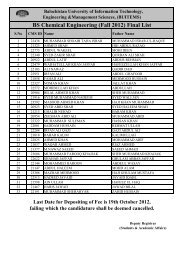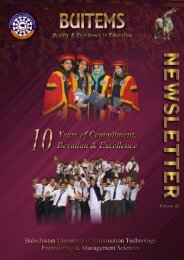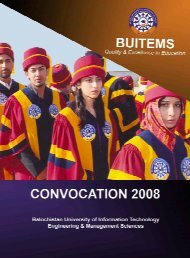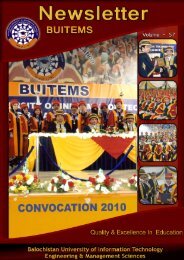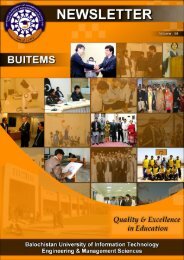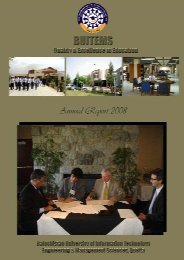BUITEMS
Research Journal - buitems
Research Journal - buitems
- No tags were found...
You also want an ePaper? Increase the reach of your titles
YUMPU automatically turns print PDFs into web optimized ePapers that Google loves.
<strong>BUITEMS</strong><br />
Quality & Excellence in Education<br />
Exploring the Impact of Trade Liberalization on Economic Growth for Pakistan<br />
by 2000-01 and in 2006-07 it was 36 percent.<br />
The share of raw materials for consumer<br />
goods also shows a declining trend over the<br />
entire period, in 180-81 it was 50 percent and<br />
declined to 40 percent in 1985-86, it was<br />
increased to 55 percent in 200-01 and then<br />
again declined to 47 percent in 2006-07. The<br />
share of imported inputs for capital good has<br />
remained less than 10 percent throughout<br />
the period. The share of imports of final<br />
consumer goods increased from 14 percent<br />
to 18 percent over the periods from 1980-86<br />
and it was reduced to 10 percent in 2006-7<br />
Over the time, significant changes can be<br />
observable in the structure of exports. The<br />
share of exports of primary goods in 2006-07<br />
is even less than one third of the 1980-81<br />
level. The share of exports of semimanufactured<br />
goods has increased from 11<br />
percent to 24 percent over the period of<br />
1980-81 to 1990-91, but declined to 11<br />
percent in 2006-07. However, the exports of<br />
manufactured goods show a consistently<br />
increasing trend. Its share increases from 45<br />
percent to 72 percent over the 20 years<br />
period and it further increased to 78 percent<br />
in 2006-07 (Table 1)<br />
Table 1: Share of Exports by Economic Classification<br />
(Percentages).<br />
Source: Economic Survey of Pakistan (various issues)<br />
On the basis of this discussion we can say<br />
that trade liberalization and natural resource<br />
endowments are not the major factors behind<br />
the economic growth. Institutional setup is<br />
also an important stimulator for the economic<br />
performance of any country. It will be an<br />
interesting study to explore the impact of<br />
trade liberalization on economic growth in<br />
case of Pakistan. The growth rates of post<br />
liberalization decades and export<br />
compositions are portraying two opposite<br />
scenarios. It will be exiting to explore the<br />
impact of trade liberalization on economic<br />
growth of Pakistan (World Development<br />
Report, 1989).<br />
Estimation and Analysis<br />
The endogenous growth theory provides a<br />
good theoretical framework for understanding<br />
the relationship between trade policies<br />
and economic growth. In order to explore the<br />
relationship between economic growth and<br />
trade liberalization, I am intended to use<br />
human capital model of endogenous growth<br />
model with little augmentation through incorporating<br />
two additional variables of trade<br />
liberalization and foreign direct investment.<br />
The present study examines validity of Lucas<br />
(1988) model in the context of Pakistan.<br />
Since, the functional form of our model is<br />
nonlinear in its nature; consequently, we will<br />
use the functional relation after taking the<br />
natural log on both sides. Hence our final<br />
model will be:<br />
Where:<br />
Y =Gross Domestic Product (Measured in billions<br />
of current US $).<br />
L= Labor Force (Measured in millions)<br />
K = Gross Capital Formation. (Measured in millions<br />
of current US $).<br />
FDI = Foreign Direct Investment (Measured in<br />
thousands of current US $)<br />
OT= (Import + Export/ GDP) (Economics openness<br />
or Trade intensity)<br />
ln= natural log<br />
e t is the random error term.<br />
We can estimate the quantitative linkage<br />
relationship between among different<br />
variables related to economic performance<br />
by estimating equation (1). The additional<br />
benefit of using natural log is that our<br />
estimated coefficient will provide us the<br />
information regarding the elasticity of<br />
independent variables and the GDP. Since,<br />
we need to satisfy different criterions while<br />
establishing a quantitative linkage among<br />
variables, all the procedures are explained in<br />
forthcoming lines.<br />
Data sources<br />
All the data on above mentioned variables<br />
was taken from World Development<br />
Indicators (World Bank) and Economic<br />
Survey of Pakistan.<br />
75



